Coaching and Feedback Management: University Report Analysis
VerifiedAdded on 2023/04/07
|11
|2872
|244
Report
AI Summary
This report delves into the critical roles of coaching and feedback management within organizational contexts. It explores how coaching sessions, utilizing knowledge and tools, aid employees in personal and professional development, aligning individual goals with organizational objectives. The report emphasizes the importance of feedback processes as mechanisms for controlling and improving managerial and employee conduct, highlighting evaluation, appreciation, and coaching feedback types. It analyzes the perspectives of various scholars, including Li N et al. (2011), Luthans and Peterson (2004), Grant (2009), and Davis, Huffman, and Alayan, examining their research on career management, 360-degree feedback systems, and the impact of coaching on undergraduate students. The report also discusses different coaching models and their application in addressing employee needs. Overall, the report underscores the significance of coaching and feedback in enhancing employee performance, fostering self-awareness, and contributing to organizational success. The report uses empirical research review presentation & paper guidelines, which include the core articles and additional empirical articles to add depth to the topic area.
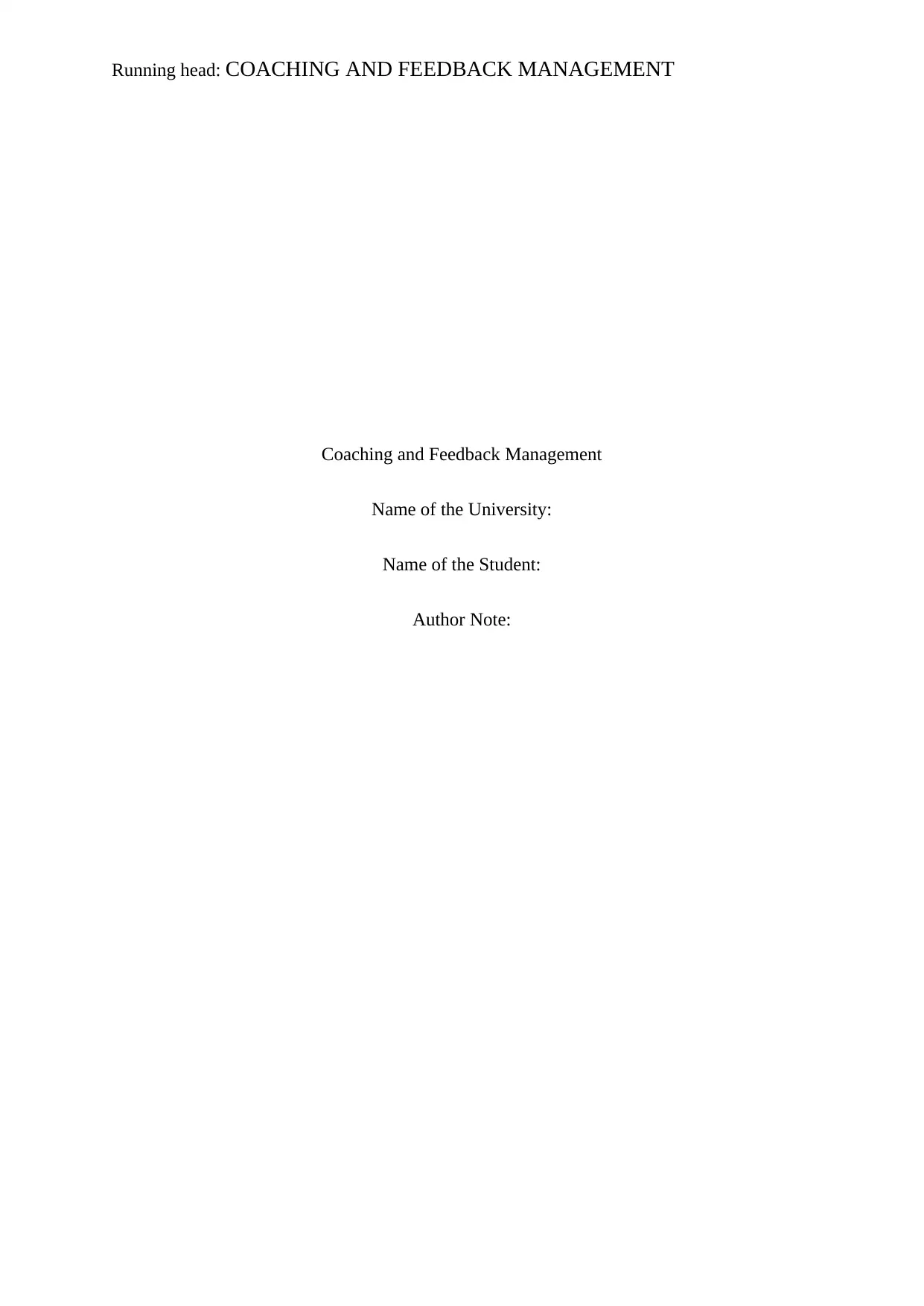
Running head: COACHING AND FEEDBACK MANAGEMENT
Coaching and Feedback Management
Name of the University:
Name of the Student:
Author Note:
Coaching and Feedback Management
Name of the University:
Name of the Student:
Author Note:
Paraphrase This Document
Need a fresh take? Get an instant paraphrase of this document with our AI Paraphraser
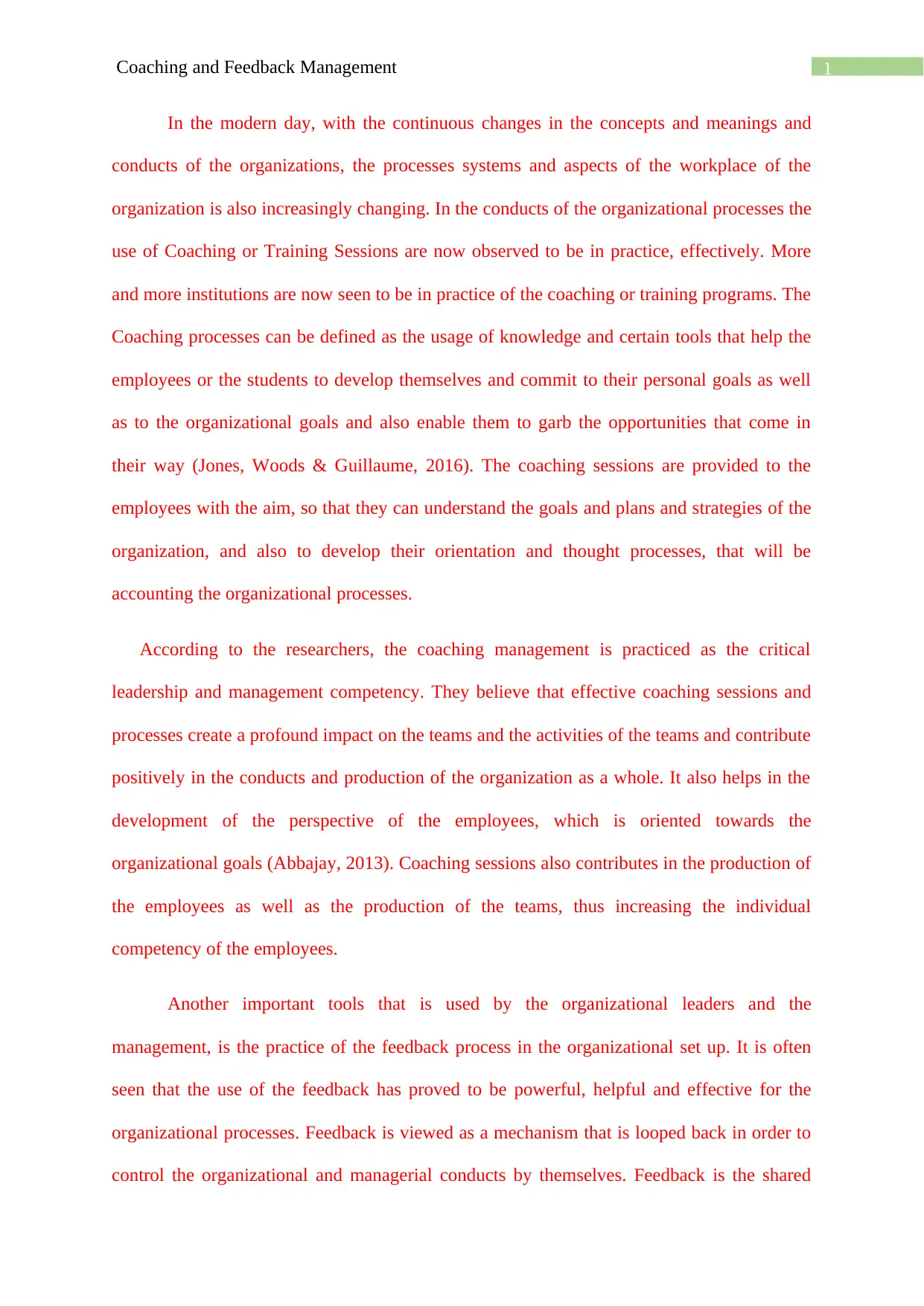
1Coaching and Feedback Management
In the modern day, with the continuous changes in the concepts and meanings and
conducts of the organizations, the processes systems and aspects of the workplace of the
organization is also increasingly changing. In the conducts of the organizational processes the
use of Coaching or Training Sessions are now observed to be in practice, effectively. More
and more institutions are now seen to be in practice of the coaching or training programs. The
Coaching processes can be defined as the usage of knowledge and certain tools that help the
employees or the students to develop themselves and commit to their personal goals as well
as to the organizational goals and also enable them to garb the opportunities that come in
their way (Jones, Woods & Guillaume, 2016). The coaching sessions are provided to the
employees with the aim, so that they can understand the goals and plans and strategies of the
organization, and also to develop their orientation and thought processes, that will be
accounting the organizational processes.
According to the researchers, the coaching management is practiced as the critical
leadership and management competency. They believe that effective coaching sessions and
processes create a profound impact on the teams and the activities of the teams and contribute
positively in the conducts and production of the organization as a whole. It also helps in the
development of the perspective of the employees, which is oriented towards the
organizational goals (Abbajay, 2013). Coaching sessions also contributes in the production of
the employees as well as the production of the teams, thus increasing the individual
competency of the employees.
Another important tools that is used by the organizational leaders and the
management, is the practice of the feedback process in the organizational set up. It is often
seen that the use of the feedback has proved to be powerful, helpful and effective for the
organizational processes. Feedback is viewed as a mechanism that is looped back in order to
control the organizational and managerial conducts by themselves. Feedback is the shared
In the modern day, with the continuous changes in the concepts and meanings and
conducts of the organizations, the processes systems and aspects of the workplace of the
organization is also increasingly changing. In the conducts of the organizational processes the
use of Coaching or Training Sessions are now observed to be in practice, effectively. More
and more institutions are now seen to be in practice of the coaching or training programs. The
Coaching processes can be defined as the usage of knowledge and certain tools that help the
employees or the students to develop themselves and commit to their personal goals as well
as to the organizational goals and also enable them to garb the opportunities that come in
their way (Jones, Woods & Guillaume, 2016). The coaching sessions are provided to the
employees with the aim, so that they can understand the goals and plans and strategies of the
organization, and also to develop their orientation and thought processes, that will be
accounting the organizational processes.
According to the researchers, the coaching management is practiced as the critical
leadership and management competency. They believe that effective coaching sessions and
processes create a profound impact on the teams and the activities of the teams and contribute
positively in the conducts and production of the organization as a whole. It also helps in the
development of the perspective of the employees, which is oriented towards the
organizational goals (Abbajay, 2013). Coaching sessions also contributes in the production of
the employees as well as the production of the teams, thus increasing the individual
competency of the employees.
Another important tools that is used by the organizational leaders and the
management, is the practice of the feedback process in the organizational set up. It is often
seen that the use of the feedback has proved to be powerful, helpful and effective for the
organizational processes. Feedback is viewed as a mechanism that is looped back in order to
control the organizational and managerial conducts by themselves. Feedback is the shared
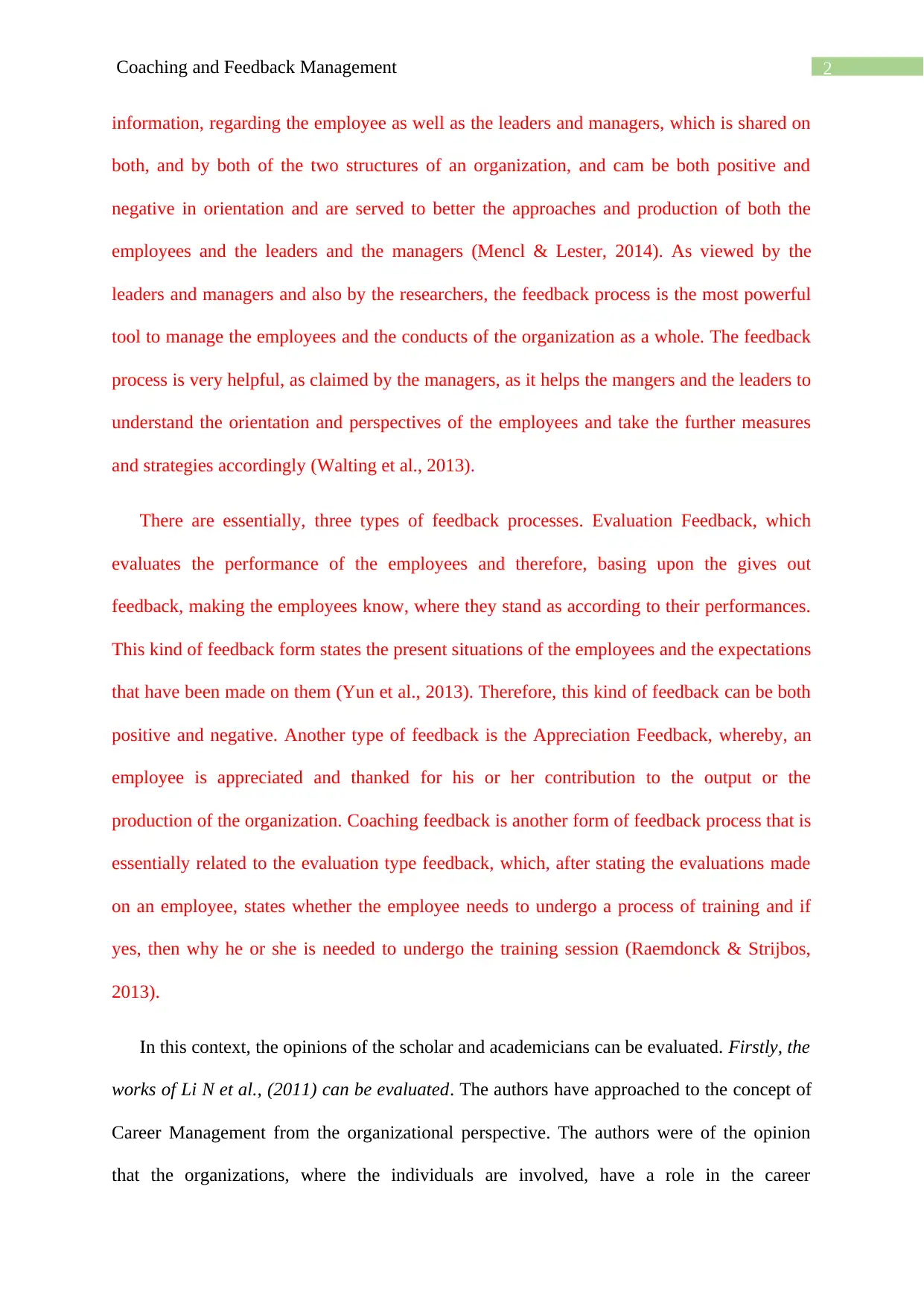
2Coaching and Feedback Management
information, regarding the employee as well as the leaders and managers, which is shared on
both, and by both of the two structures of an organization, and cam be both positive and
negative in orientation and are served to better the approaches and production of both the
employees and the leaders and the managers (Mencl & Lester, 2014). As viewed by the
leaders and managers and also by the researchers, the feedback process is the most powerful
tool to manage the employees and the conducts of the organization as a whole. The feedback
process is very helpful, as claimed by the managers, as it helps the mangers and the leaders to
understand the orientation and perspectives of the employees and take the further measures
and strategies accordingly (Walting et al., 2013).
There are essentially, three types of feedback processes. Evaluation Feedback, which
evaluates the performance of the employees and therefore, basing upon the gives out
feedback, making the employees know, where they stand as according to their performances.
This kind of feedback form states the present situations of the employees and the expectations
that have been made on them (Yun et al., 2013). Therefore, this kind of feedback can be both
positive and negative. Another type of feedback is the Appreciation Feedback, whereby, an
employee is appreciated and thanked for his or her contribution to the output or the
production of the organization. Coaching feedback is another form of feedback process that is
essentially related to the evaluation type feedback, which, after stating the evaluations made
on an employee, states whether the employee needs to undergo a process of training and if
yes, then why he or she is needed to undergo the training session (Raemdonck & Strijbos,
2013).
In this context, the opinions of the scholar and academicians can be evaluated. Firstly, the
works of Li N et al., (2011) can be evaluated. The authors have approached to the concept of
Career Management from the organizational perspective. The authors were of the opinion
that the organizations, where the individuals are involved, have a role in the career
information, regarding the employee as well as the leaders and managers, which is shared on
both, and by both of the two structures of an organization, and cam be both positive and
negative in orientation and are served to better the approaches and production of both the
employees and the leaders and the managers (Mencl & Lester, 2014). As viewed by the
leaders and managers and also by the researchers, the feedback process is the most powerful
tool to manage the employees and the conducts of the organization as a whole. The feedback
process is very helpful, as claimed by the managers, as it helps the mangers and the leaders to
understand the orientation and perspectives of the employees and take the further measures
and strategies accordingly (Walting et al., 2013).
There are essentially, three types of feedback processes. Evaluation Feedback, which
evaluates the performance of the employees and therefore, basing upon the gives out
feedback, making the employees know, where they stand as according to their performances.
This kind of feedback form states the present situations of the employees and the expectations
that have been made on them (Yun et al., 2013). Therefore, this kind of feedback can be both
positive and negative. Another type of feedback is the Appreciation Feedback, whereby, an
employee is appreciated and thanked for his or her contribution to the output or the
production of the organization. Coaching feedback is another form of feedback process that is
essentially related to the evaluation type feedback, which, after stating the evaluations made
on an employee, states whether the employee needs to undergo a process of training and if
yes, then why he or she is needed to undergo the training session (Raemdonck & Strijbos,
2013).
In this context, the opinions of the scholar and academicians can be evaluated. Firstly, the
works of Li N et al., (2011) can be evaluated. The authors have approached to the concept of
Career Management from the organizational perspective. The authors were of the opinion
that the organizations, where the individuals are involved, have a role in the career
⊘ This is a preview!⊘
Do you want full access?
Subscribe today to unlock all pages.

Trusted by 1+ million students worldwide
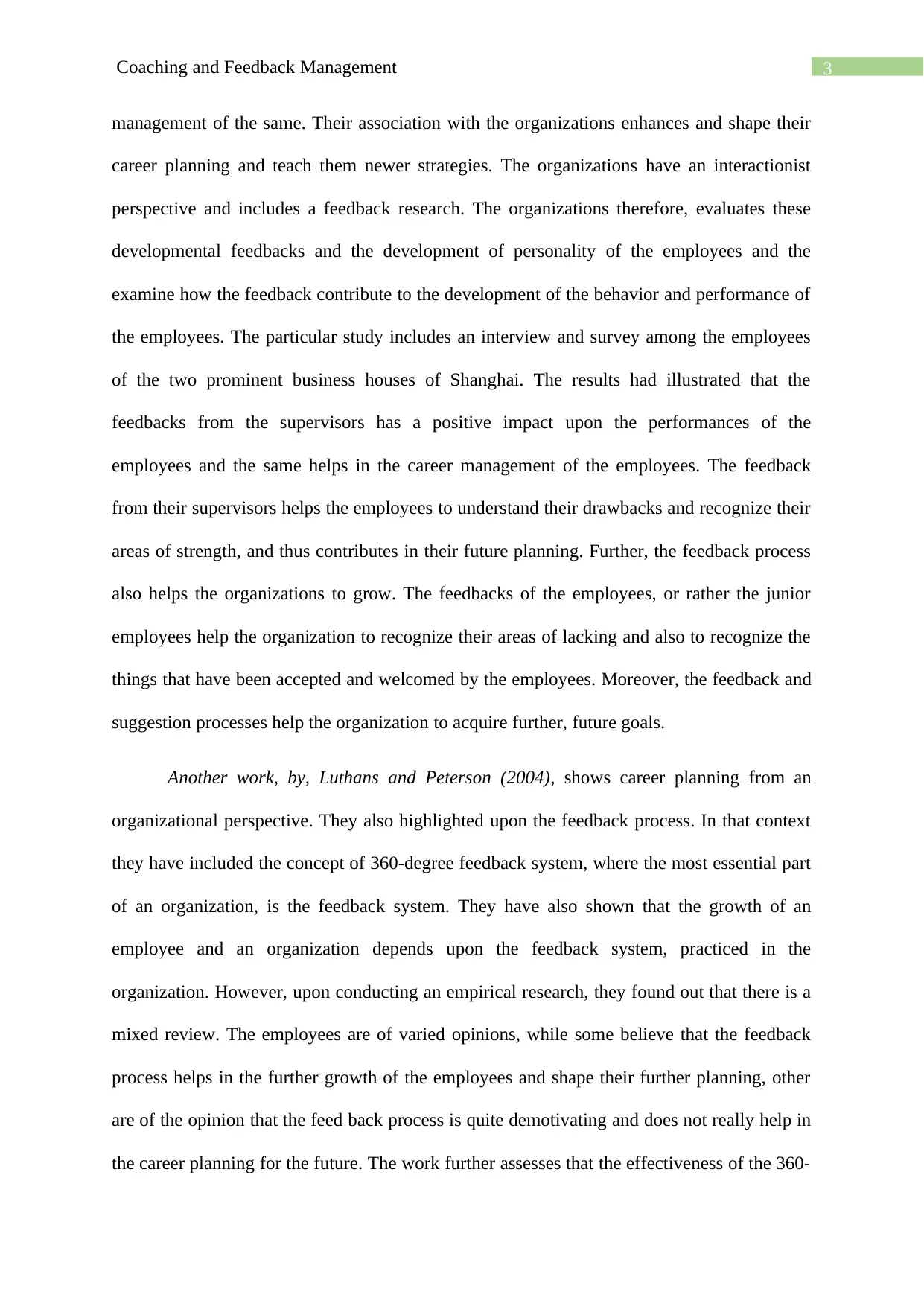
3Coaching and Feedback Management
management of the same. Their association with the organizations enhances and shape their
career planning and teach them newer strategies. The organizations have an interactionist
perspective and includes a feedback research. The organizations therefore, evaluates these
developmental feedbacks and the development of personality of the employees and the
examine how the feedback contribute to the development of the behavior and performance of
the employees. The particular study includes an interview and survey among the employees
of the two prominent business houses of Shanghai. The results had illustrated that the
feedbacks from the supervisors has a positive impact upon the performances of the
employees and the same helps in the career management of the employees. The feedback
from their supervisors helps the employees to understand their drawbacks and recognize their
areas of strength, and thus contributes in their future planning. Further, the feedback process
also helps the organizations to grow. The feedbacks of the employees, or rather the junior
employees help the organization to recognize their areas of lacking and also to recognize the
things that have been accepted and welcomed by the employees. Moreover, the feedback and
suggestion processes help the organization to acquire further, future goals.
Another work, by, Luthans and Peterson (2004), shows career planning from an
organizational perspective. They also highlighted upon the feedback process. In that context
they have included the concept of 360-degree feedback system, where the most essential part
of an organization, is the feedback system. They have also shown that the growth of an
employee and an organization depends upon the feedback system, practiced in the
organization. However, upon conducting an empirical research, they found out that there is a
mixed review. The employees are of varied opinions, while some believe that the feedback
process helps in the further growth of the employees and shape their further planning, other
are of the opinion that the feed back process is quite demotivating and does not really help in
the career planning for the future. The work further assesses that the effectiveness of the 360-
management of the same. Their association with the organizations enhances and shape their
career planning and teach them newer strategies. The organizations have an interactionist
perspective and includes a feedback research. The organizations therefore, evaluates these
developmental feedbacks and the development of personality of the employees and the
examine how the feedback contribute to the development of the behavior and performance of
the employees. The particular study includes an interview and survey among the employees
of the two prominent business houses of Shanghai. The results had illustrated that the
feedbacks from the supervisors has a positive impact upon the performances of the
employees and the same helps in the career management of the employees. The feedback
from their supervisors helps the employees to understand their drawbacks and recognize their
areas of strength, and thus contributes in their future planning. Further, the feedback process
also helps the organizations to grow. The feedbacks of the employees, or rather the junior
employees help the organization to recognize their areas of lacking and also to recognize the
things that have been accepted and welcomed by the employees. Moreover, the feedback and
suggestion processes help the organization to acquire further, future goals.
Another work, by, Luthans and Peterson (2004), shows career planning from an
organizational perspective. They also highlighted upon the feedback process. In that context
they have included the concept of 360-degree feedback system, where the most essential part
of an organization, is the feedback system. They have also shown that the growth of an
employee and an organization depends upon the feedback system, practiced in the
organization. However, upon conducting an empirical research, they found out that there is a
mixed review. The employees are of varied opinions, while some believe that the feedback
process helps in the further growth of the employees and shape their further planning, other
are of the opinion that the feed back process is quite demotivating and does not really help in
the career planning for the future. The work further assesses that the effectiveness of the 360-
Paraphrase This Document
Need a fresh take? Get an instant paraphrase of this document with our AI Paraphraser
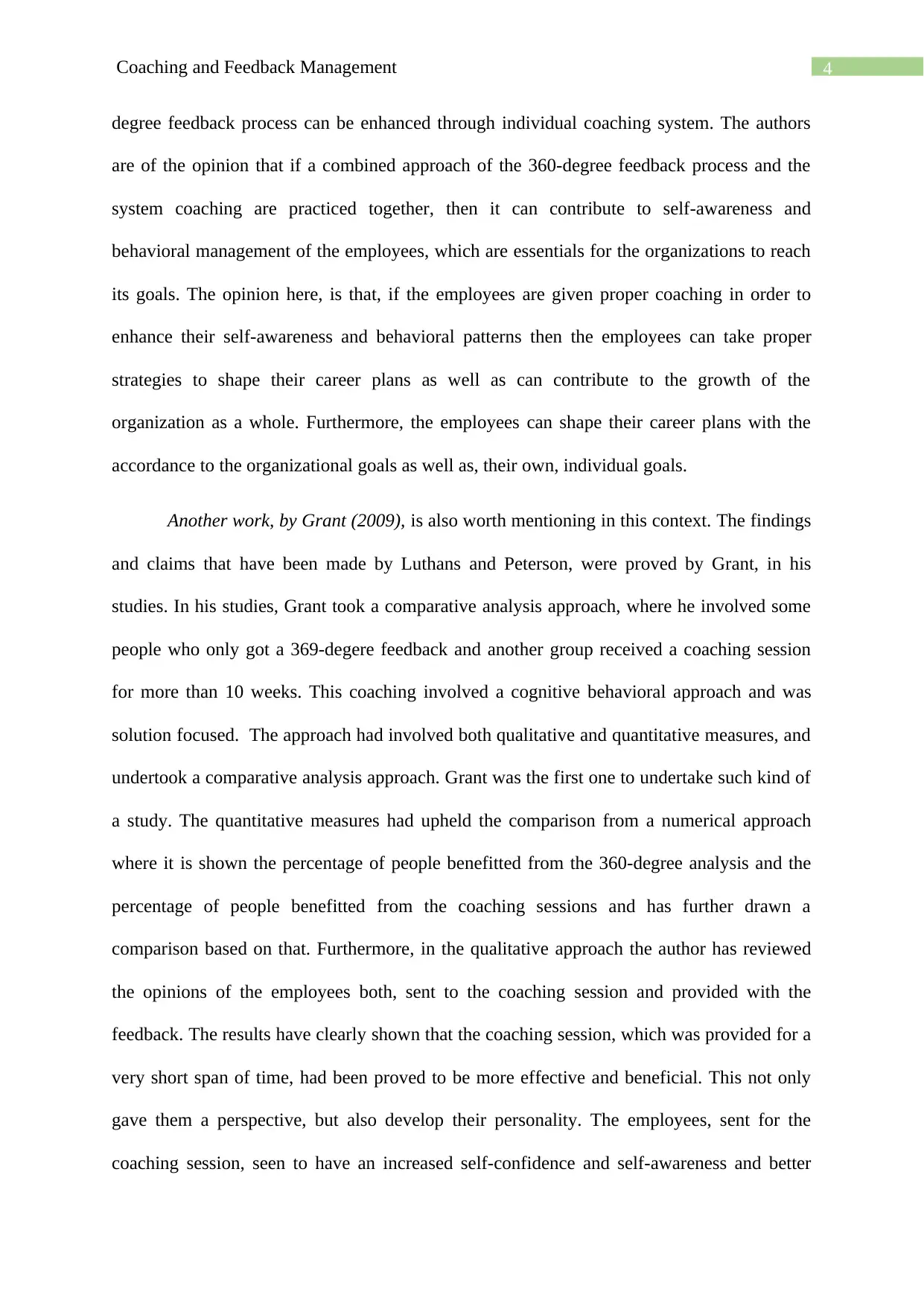
4Coaching and Feedback Management
degree feedback process can be enhanced through individual coaching system. The authors
are of the opinion that if a combined approach of the 360-degree feedback process and the
system coaching are practiced together, then it can contribute to self-awareness and
behavioral management of the employees, which are essentials for the organizations to reach
its goals. The opinion here, is that, if the employees are given proper coaching in order to
enhance their self-awareness and behavioral patterns then the employees can take proper
strategies to shape their career plans as well as can contribute to the growth of the
organization as a whole. Furthermore, the employees can shape their career plans with the
accordance to the organizational goals as well as, their own, individual goals.
Another work, by Grant (2009), is also worth mentioning in this context. The findings
and claims that have been made by Luthans and Peterson, were proved by Grant, in his
studies. In his studies, Grant took a comparative analysis approach, where he involved some
people who only got a 369-degere feedback and another group received a coaching session
for more than 10 weeks. This coaching involved a cognitive behavioral approach and was
solution focused. The approach had involved both qualitative and quantitative measures, and
undertook a comparative analysis approach. Grant was the first one to undertake such kind of
a study. The quantitative measures had upheld the comparison from a numerical approach
where it is shown the percentage of people benefitted from the 360-degree analysis and the
percentage of people benefitted from the coaching sessions and has further drawn a
comparison based on that. Furthermore, in the qualitative approach the author has reviewed
the opinions of the employees both, sent to the coaching session and provided with the
feedback. The results have clearly shown that the coaching session, which was provided for a
very short span of time, had been proved to be more effective and beneficial. This not only
gave them a perspective, but also develop their personality. The employees, sent for the
coaching session, seen to have an increased self-confidence and self-awareness and better
degree feedback process can be enhanced through individual coaching system. The authors
are of the opinion that if a combined approach of the 360-degree feedback process and the
system coaching are practiced together, then it can contribute to self-awareness and
behavioral management of the employees, which are essentials for the organizations to reach
its goals. The opinion here, is that, if the employees are given proper coaching in order to
enhance their self-awareness and behavioral patterns then the employees can take proper
strategies to shape their career plans as well as can contribute to the growth of the
organization as a whole. Furthermore, the employees can shape their career plans with the
accordance to the organizational goals as well as, their own, individual goals.
Another work, by Grant (2009), is also worth mentioning in this context. The findings
and claims that have been made by Luthans and Peterson, were proved by Grant, in his
studies. In his studies, Grant took a comparative analysis approach, where he involved some
people who only got a 369-degere feedback and another group received a coaching session
for more than 10 weeks. This coaching involved a cognitive behavioral approach and was
solution focused. The approach had involved both qualitative and quantitative measures, and
undertook a comparative analysis approach. Grant was the first one to undertake such kind of
a study. The quantitative measures had upheld the comparison from a numerical approach
where it is shown the percentage of people benefitted from the 360-degree analysis and the
percentage of people benefitted from the coaching sessions and has further drawn a
comparison based on that. Furthermore, in the qualitative approach the author has reviewed
the opinions of the employees both, sent to the coaching session and provided with the
feedback. The results have clearly shown that the coaching session, which was provided for a
very short span of time, had been proved to be more effective and beneficial. This not only
gave them a perspective, but also develop their personality. The employees, sent for the
coaching session, seen to have an increased self-confidence and self-awareness and better
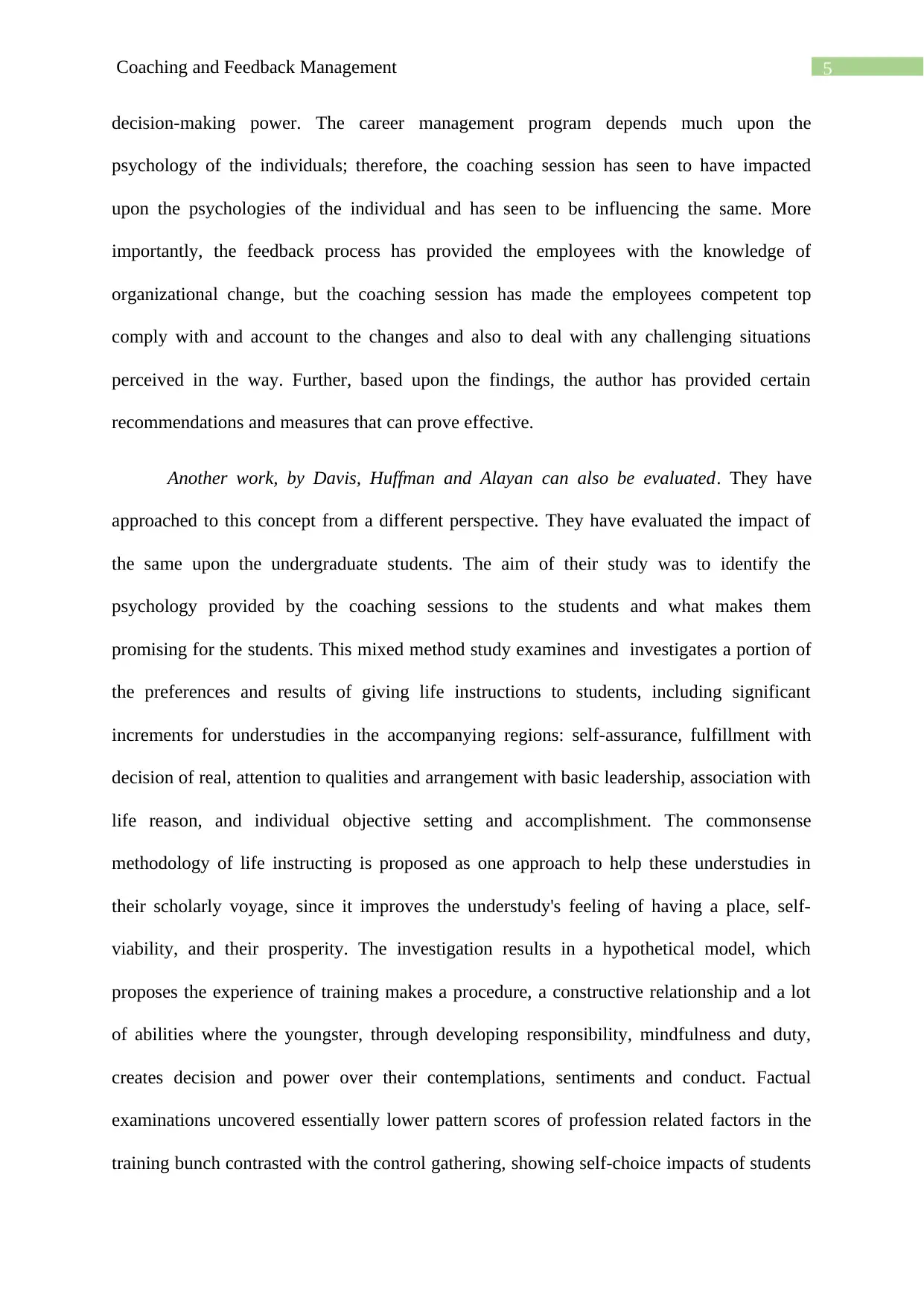
5Coaching and Feedback Management
decision-making power. The career management program depends much upon the
psychology of the individuals; therefore, the coaching session has seen to have impacted
upon the psychologies of the individual and has seen to be influencing the same. More
importantly, the feedback process has provided the employees with the knowledge of
organizational change, but the coaching session has made the employees competent top
comply with and account to the changes and also to deal with any challenging situations
perceived in the way. Further, based upon the findings, the author has provided certain
recommendations and measures that can prove effective.
Another work, by Davis, Huffman and Alayan can also be evaluated. They have
approached to this concept from a different perspective. They have evaluated the impact of
the same upon the undergraduate students. The aim of their study was to identify the
psychology provided by the coaching sessions to the students and what makes them
promising for the students. This mixed method study examines and investigates a portion of
the preferences and results of giving life instructions to students, including significant
increments for understudies in the accompanying regions: self-assurance, fulfillment with
decision of real, attention to qualities and arrangement with basic leadership, association with
life reason, and individual objective setting and accomplishment. The commonsense
methodology of life instructing is proposed as one approach to help these understudies in
their scholarly voyage, since it improves the understudy's feeling of having a place, self-
viability, and their prosperity. The investigation results in a hypothetical model, which
proposes the experience of training makes a procedure, a constructive relationship and a lot
of abilities where the youngster, through developing responsibility, mindfulness and duty,
creates decision and power over their contemplations, sentiments and conduct. Factual
examinations uncovered essentially lower pattern scores of profession related factors in the
training bunch contrasted with the control gathering, showing self-choice impacts of students
decision-making power. The career management program depends much upon the
psychology of the individuals; therefore, the coaching session has seen to have impacted
upon the psychologies of the individual and has seen to be influencing the same. More
importantly, the feedback process has provided the employees with the knowledge of
organizational change, but the coaching session has made the employees competent top
comply with and account to the changes and also to deal with any challenging situations
perceived in the way. Further, based upon the findings, the author has provided certain
recommendations and measures that can prove effective.
Another work, by Davis, Huffman and Alayan can also be evaluated. They have
approached to this concept from a different perspective. They have evaluated the impact of
the same upon the undergraduate students. The aim of their study was to identify the
psychology provided by the coaching sessions to the students and what makes them
promising for the students. This mixed method study examines and investigates a portion of
the preferences and results of giving life instructions to students, including significant
increments for understudies in the accompanying regions: self-assurance, fulfillment with
decision of real, attention to qualities and arrangement with basic leadership, association with
life reason, and individual objective setting and accomplishment. The commonsense
methodology of life instructing is proposed as one approach to help these understudies in
their scholarly voyage, since it improves the understudy's feeling of having a place, self-
viability, and their prosperity. The investigation results in a hypothetical model, which
proposes the experience of training makes a procedure, a constructive relationship and a lot
of abilities where the youngster, through developing responsibility, mindfulness and duty,
creates decision and power over their contemplations, sentiments and conduct. Factual
examinations uncovered essentially lower pattern scores of profession related factors in the
training bunch contrasted with the control gathering, showing self-choice impacts of students
⊘ This is a preview!⊘
Do you want full access?
Subscribe today to unlock all pages.

Trusted by 1+ million students worldwide
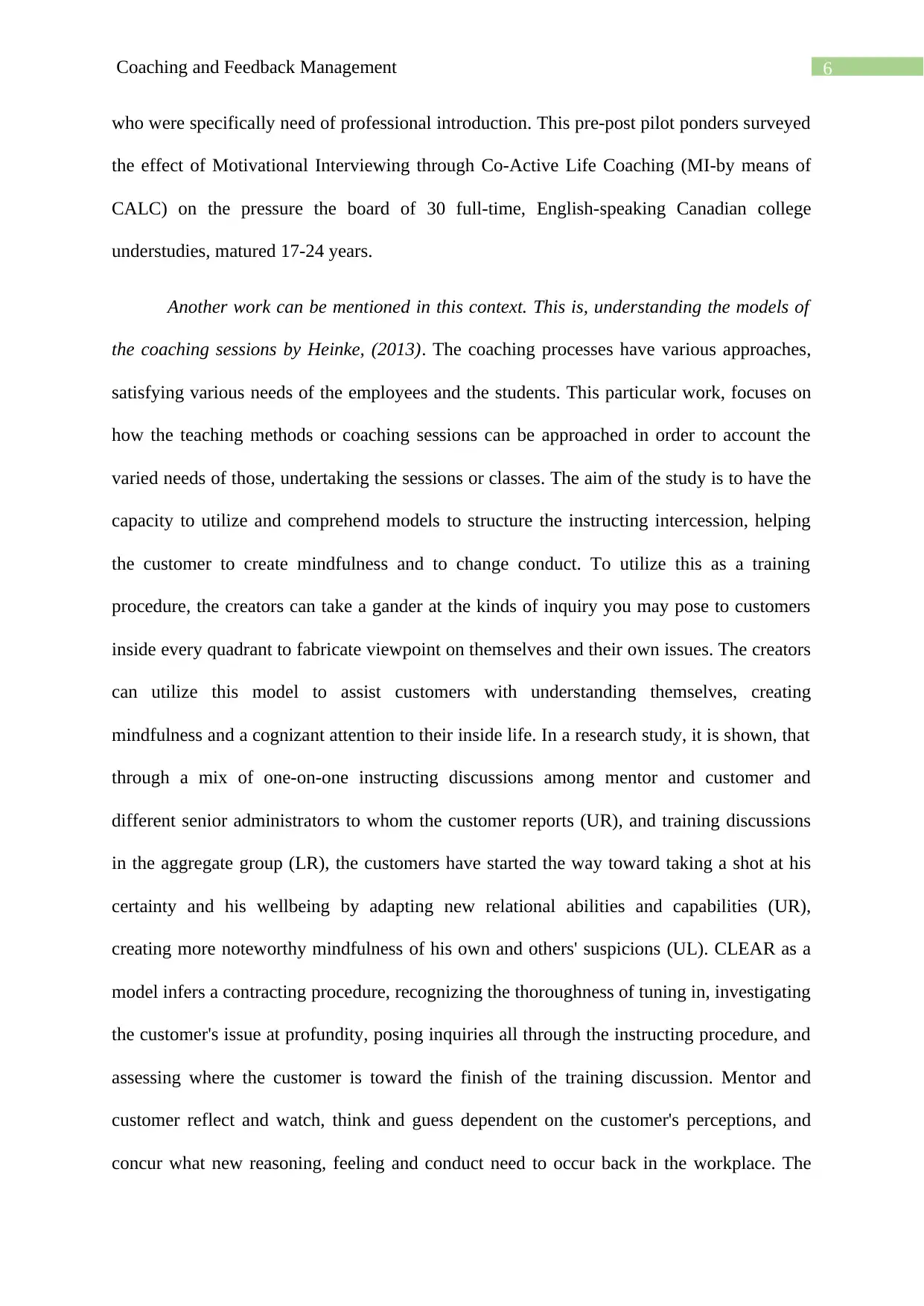
6Coaching and Feedback Management
who were specifically need of professional introduction. This pre-post pilot ponders surveyed
the effect of Motivational Interviewing through Co-Active Life Coaching (MI-by means of
CALC) on the pressure the board of 30 full-time, English-speaking Canadian college
understudies, matured 17-24 years.
Another work can be mentioned in this context. This is, understanding the models of
the coaching sessions by Heinke, (2013). The coaching processes have various approaches,
satisfying various needs of the employees and the students. This particular work, focuses on
how the teaching methods or coaching sessions can be approached in order to account the
varied needs of those, undertaking the sessions or classes. The aim of the study is to have the
capacity to utilize and comprehend models to structure the instructing intercession, helping
the customer to create mindfulness and to change conduct. To utilize this as a training
procedure, the creators can take a gander at the kinds of inquiry you may pose to customers
inside every quadrant to fabricate viewpoint on themselves and their own issues. The creators
can utilize this model to assist customers with understanding themselves, creating
mindfulness and a cognizant attention to their inside life. In a research study, it is shown, that
through a mix of one-on-one instructing discussions among mentor and customer and
different senior administrators to whom the customer reports (UR), and training discussions
in the aggregate group (LR), the customers have started the way toward taking a shot at his
certainty and his wellbeing by adapting new relational abilities and capabilities (UR),
creating more noteworthy mindfulness of his own and others' suspicions (UL). CLEAR as a
model infers a contracting procedure, recognizing the thoroughness of tuning in, investigating
the customer's issue at profundity, posing inquiries all through the instructing procedure, and
assessing where the customer is toward the finish of the training discussion. Mentor and
customer reflect and watch, think and guess dependent on the customer's perceptions, and
concur what new reasoning, feeling and conduct need to occur back in the workplace. The
who were specifically need of professional introduction. This pre-post pilot ponders surveyed
the effect of Motivational Interviewing through Co-Active Life Coaching (MI-by means of
CALC) on the pressure the board of 30 full-time, English-speaking Canadian college
understudies, matured 17-24 years.
Another work can be mentioned in this context. This is, understanding the models of
the coaching sessions by Heinke, (2013). The coaching processes have various approaches,
satisfying various needs of the employees and the students. This particular work, focuses on
how the teaching methods or coaching sessions can be approached in order to account the
varied needs of those, undertaking the sessions or classes. The aim of the study is to have the
capacity to utilize and comprehend models to structure the instructing intercession, helping
the customer to create mindfulness and to change conduct. To utilize this as a training
procedure, the creators can take a gander at the kinds of inquiry you may pose to customers
inside every quadrant to fabricate viewpoint on themselves and their own issues. The creators
can utilize this model to assist customers with understanding themselves, creating
mindfulness and a cognizant attention to their inside life. In a research study, it is shown, that
through a mix of one-on-one instructing discussions among mentor and customer and
different senior administrators to whom the customer reports (UR), and training discussions
in the aggregate group (LR), the customers have started the way toward taking a shot at his
certainty and his wellbeing by adapting new relational abilities and capabilities (UR),
creating more noteworthy mindfulness of his own and others' suspicions (UL). CLEAR as a
model infers a contracting procedure, recognizing the thoroughness of tuning in, investigating
the customer's issue at profundity, posing inquiries all through the instructing procedure, and
assessing where the customer is toward the finish of the training discussion. Mentor and
customer reflect and watch, think and guess dependent on the customer's perceptions, and
concur what new reasoning, feeling and conduct need to occur back in the workplace. The
Paraphrase This Document
Need a fresh take? Get an instant paraphrase of this document with our AI Paraphraser
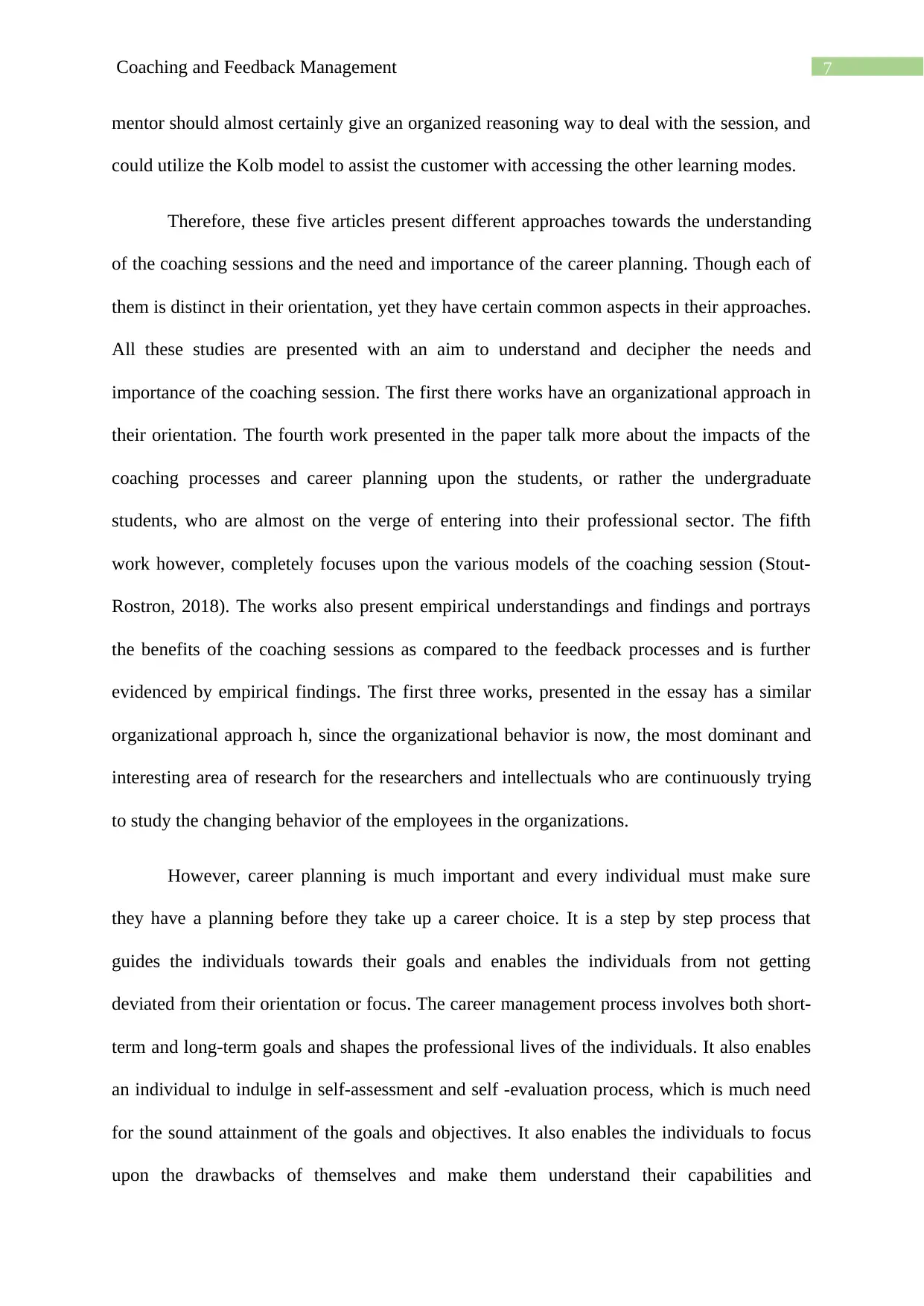
7Coaching and Feedback Management
mentor should almost certainly give an organized reasoning way to deal with the session, and
could utilize the Kolb model to assist the customer with accessing the other learning modes.
Therefore, these five articles present different approaches towards the understanding
of the coaching sessions and the need and importance of the career planning. Though each of
them is distinct in their orientation, yet they have certain common aspects in their approaches.
All these studies are presented with an aim to understand and decipher the needs and
importance of the coaching session. The first there works have an organizational approach in
their orientation. The fourth work presented in the paper talk more about the impacts of the
coaching processes and career planning upon the students, or rather the undergraduate
students, who are almost on the verge of entering into their professional sector. The fifth
work however, completely focuses upon the various models of the coaching session (Stout-
Rostron, 2018). The works also present empirical understandings and findings and portrays
the benefits of the coaching sessions as compared to the feedback processes and is further
evidenced by empirical findings. The first three works, presented in the essay has a similar
organizational approach h, since the organizational behavior is now, the most dominant and
interesting area of research for the researchers and intellectuals who are continuously trying
to study the changing behavior of the employees in the organizations.
However, career planning is much important and every individual must make sure
they have a planning before they take up a career choice. It is a step by step process that
guides the individuals towards their goals and enables the individuals from not getting
deviated from their orientation or focus. The career management process involves both short-
term and long-term goals and shapes the professional lives of the individuals. It also enables
an individual to indulge in self-assessment and self -evaluation process, which is much need
for the sound attainment of the goals and objectives. It also enables the individuals to focus
upon the drawbacks of themselves and make them understand their capabilities and
mentor should almost certainly give an organized reasoning way to deal with the session, and
could utilize the Kolb model to assist the customer with accessing the other learning modes.
Therefore, these five articles present different approaches towards the understanding
of the coaching sessions and the need and importance of the career planning. Though each of
them is distinct in their orientation, yet they have certain common aspects in their approaches.
All these studies are presented with an aim to understand and decipher the needs and
importance of the coaching session. The first there works have an organizational approach in
their orientation. The fourth work presented in the paper talk more about the impacts of the
coaching processes and career planning upon the students, or rather the undergraduate
students, who are almost on the verge of entering into their professional sector. The fifth
work however, completely focuses upon the various models of the coaching session (Stout-
Rostron, 2018). The works also present empirical understandings and findings and portrays
the benefits of the coaching sessions as compared to the feedback processes and is further
evidenced by empirical findings. The first three works, presented in the essay has a similar
organizational approach h, since the organizational behavior is now, the most dominant and
interesting area of research for the researchers and intellectuals who are continuously trying
to study the changing behavior of the employees in the organizations.
However, career planning is much important and every individual must make sure
they have a planning before they take up a career choice. It is a step by step process that
guides the individuals towards their goals and enables the individuals from not getting
deviated from their orientation or focus. The career management process involves both short-
term and long-term goals and shapes the professional lives of the individuals. It also enables
an individual to indulge in self-assessment and self -evaluation process, which is much need
for the sound attainment of the goals and objectives. It also enables the individuals to focus
upon the drawbacks of themselves and make them understand their capabilities and
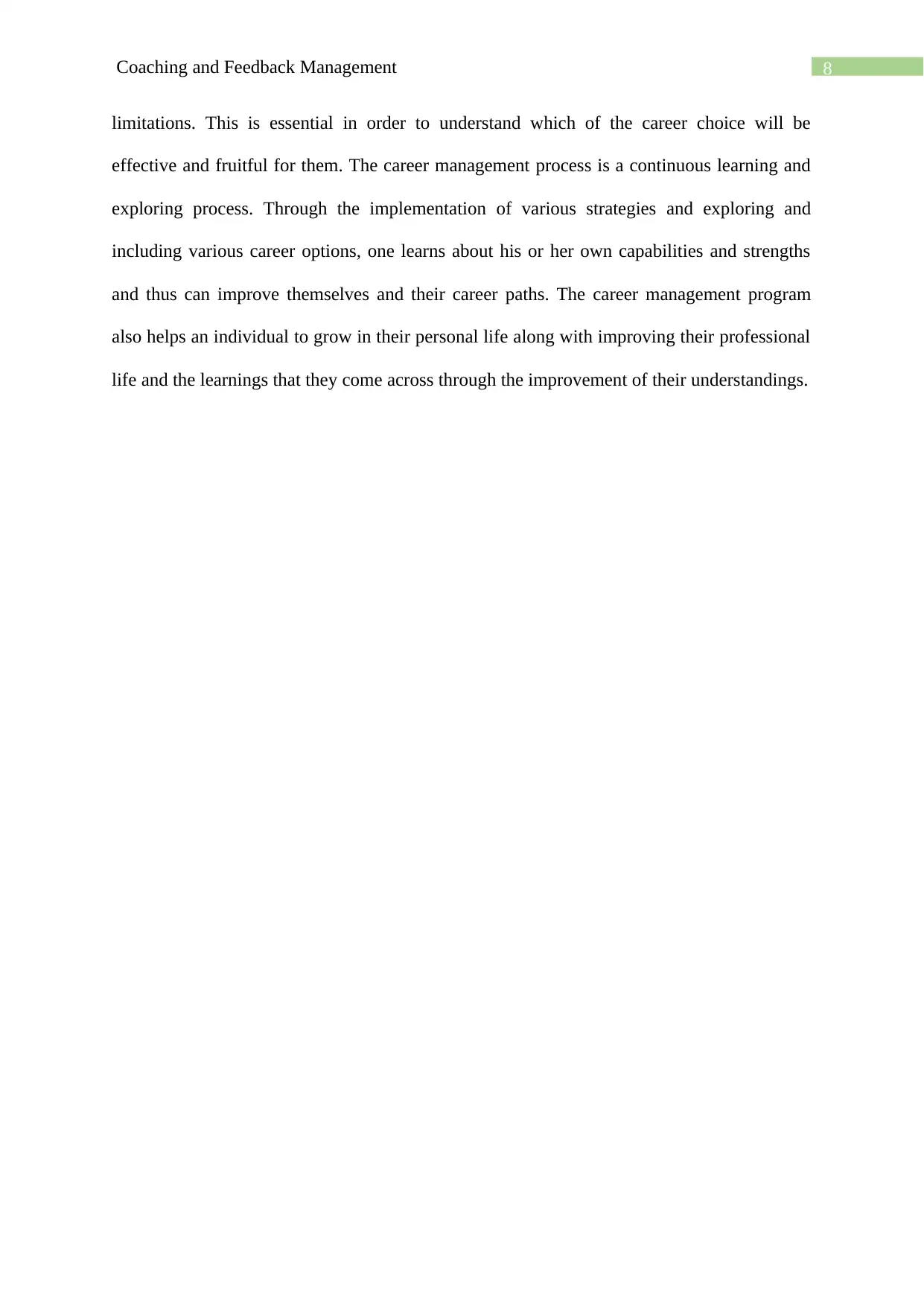
8Coaching and Feedback Management
limitations. This is essential in order to understand which of the career choice will be
effective and fruitful for them. The career management process is a continuous learning and
exploring process. Through the implementation of various strategies and exploring and
including various career options, one learns about his or her own capabilities and strengths
and thus can improve themselves and their career paths. The career management program
also helps an individual to grow in their personal life along with improving their professional
life and the learnings that they come across through the improvement of their understandings.
limitations. This is essential in order to understand which of the career choice will be
effective and fruitful for them. The career management process is a continuous learning and
exploring process. Through the implementation of various strategies and exploring and
including various career options, one learns about his or her own capabilities and strengths
and thus can improve themselves and their career paths. The career management program
also helps an individual to grow in their personal life along with improving their professional
life and the learnings that they come across through the improvement of their understandings.
⊘ This is a preview!⊘
Do you want full access?
Subscribe today to unlock all pages.

Trusted by 1+ million students worldwide
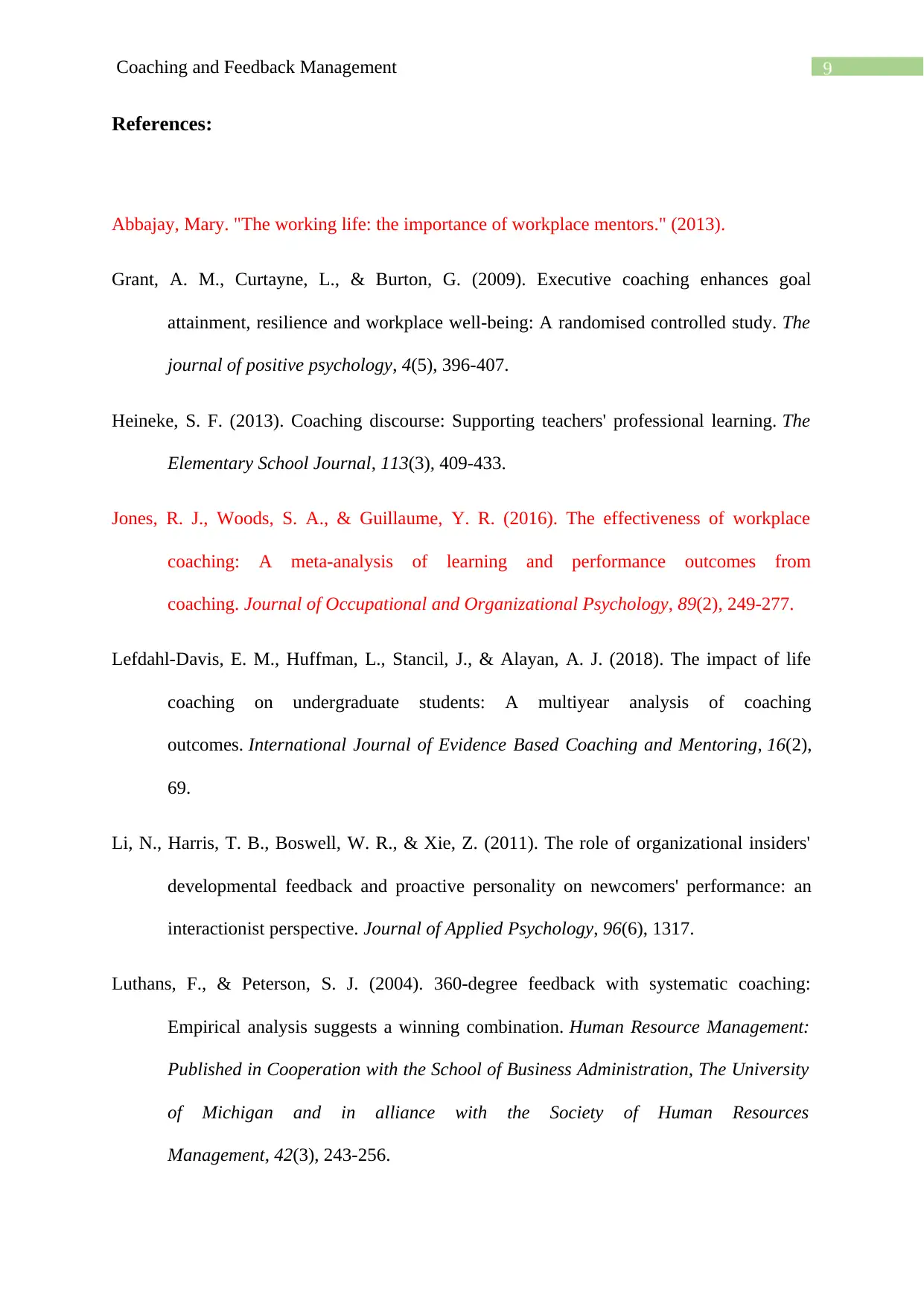
9Coaching and Feedback Management
References:
Abbajay, Mary. "The working life: the importance of workplace mentors." (2013).
Grant, A. M., Curtayne, L., & Burton, G. (2009). Executive coaching enhances goal
attainment, resilience and workplace well-being: A randomised controlled study. The
journal of positive psychology, 4(5), 396-407.
Heineke, S. F. (2013). Coaching discourse: Supporting teachers' professional learning. The
Elementary School Journal, 113(3), 409-433.
Jones, R. J., Woods, S. A., & Guillaume, Y. R. (2016). The effectiveness of workplace
coaching: A meta‐analysis of learning and performance outcomes from
coaching. Journal of Occupational and Organizational Psychology, 89(2), 249-277.
Lefdahl-Davis, E. M., Huffman, L., Stancil, J., & Alayan, A. J. (2018). The impact of life
coaching on undergraduate students: A multiyear analysis of coaching
outcomes. International Journal of Evidence Based Coaching and Mentoring, 16(2),
69.
Li, N., Harris, T. B., Boswell, W. R., & Xie, Z. (2011). The role of organizational insiders'
developmental feedback and proactive personality on newcomers' performance: an
interactionist perspective. Journal of Applied Psychology, 96(6), 1317.
Luthans, F., & Peterson, S. J. (2004). 360‐degree feedback with systematic coaching:
Empirical analysis suggests a winning combination. Human Resource Management:
Published in Cooperation with the School of Business Administration, The University
of Michigan and in alliance with the Society of Human Resources
Management, 42(3), 243-256.
References:
Abbajay, Mary. "The working life: the importance of workplace mentors." (2013).
Grant, A. M., Curtayne, L., & Burton, G. (2009). Executive coaching enhances goal
attainment, resilience and workplace well-being: A randomised controlled study. The
journal of positive psychology, 4(5), 396-407.
Heineke, S. F. (2013). Coaching discourse: Supporting teachers' professional learning. The
Elementary School Journal, 113(3), 409-433.
Jones, R. J., Woods, S. A., & Guillaume, Y. R. (2016). The effectiveness of workplace
coaching: A meta‐analysis of learning and performance outcomes from
coaching. Journal of Occupational and Organizational Psychology, 89(2), 249-277.
Lefdahl-Davis, E. M., Huffman, L., Stancil, J., & Alayan, A. J. (2018). The impact of life
coaching on undergraduate students: A multiyear analysis of coaching
outcomes. International Journal of Evidence Based Coaching and Mentoring, 16(2),
69.
Li, N., Harris, T. B., Boswell, W. R., & Xie, Z. (2011). The role of organizational insiders'
developmental feedback and proactive personality on newcomers' performance: an
interactionist perspective. Journal of Applied Psychology, 96(6), 1317.
Luthans, F., & Peterson, S. J. (2004). 360‐degree feedback with systematic coaching:
Empirical analysis suggests a winning combination. Human Resource Management:
Published in Cooperation with the School of Business Administration, The University
of Michigan and in alliance with the Society of Human Resources
Management, 42(3), 243-256.
Paraphrase This Document
Need a fresh take? Get an instant paraphrase of this document with our AI Paraphraser
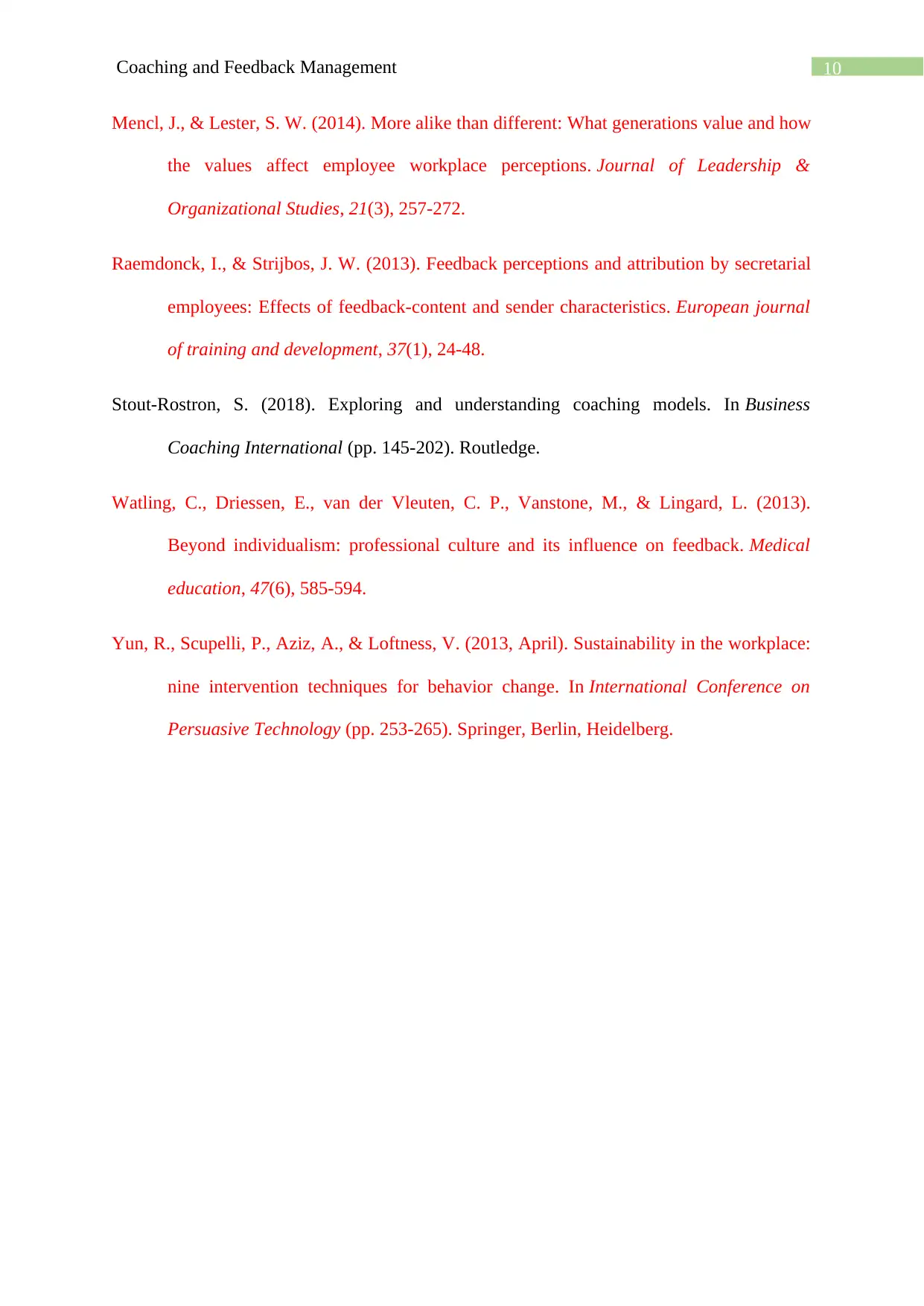
10Coaching and Feedback Management
Mencl, J., & Lester, S. W. (2014). More alike than different: What generations value and how
the values affect employee workplace perceptions. Journal of Leadership &
Organizational Studies, 21(3), 257-272.
Raemdonck, I., & Strijbos, J. W. (2013). Feedback perceptions and attribution by secretarial
employees: Effects of feedback-content and sender characteristics. European journal
of training and development, 37(1), 24-48.
Stout-Rostron, S. (2018). Exploring and understanding coaching models. In Business
Coaching International (pp. 145-202). Routledge.
Watling, C., Driessen, E., van der Vleuten, C. P., Vanstone, M., & Lingard, L. (2013).
Beyond individualism: professional culture and its influence on feedback. Medical
education, 47(6), 585-594.
Yun, R., Scupelli, P., Aziz, A., & Loftness, V. (2013, April). Sustainability in the workplace:
nine intervention techniques for behavior change. In International Conference on
Persuasive Technology (pp. 253-265). Springer, Berlin, Heidelberg.
Mencl, J., & Lester, S. W. (2014). More alike than different: What generations value and how
the values affect employee workplace perceptions. Journal of Leadership &
Organizational Studies, 21(3), 257-272.
Raemdonck, I., & Strijbos, J. W. (2013). Feedback perceptions and attribution by secretarial
employees: Effects of feedback-content and sender characteristics. European journal
of training and development, 37(1), 24-48.
Stout-Rostron, S. (2018). Exploring and understanding coaching models. In Business
Coaching International (pp. 145-202). Routledge.
Watling, C., Driessen, E., van der Vleuten, C. P., Vanstone, M., & Lingard, L. (2013).
Beyond individualism: professional culture and its influence on feedback. Medical
education, 47(6), 585-594.
Yun, R., Scupelli, P., Aziz, A., & Loftness, V. (2013, April). Sustainability in the workplace:
nine intervention techniques for behavior change. In International Conference on
Persuasive Technology (pp. 253-265). Springer, Berlin, Heidelberg.
1 out of 11
Related Documents
Your All-in-One AI-Powered Toolkit for Academic Success.
+13062052269
info@desklib.com
Available 24*7 on WhatsApp / Email
![[object Object]](/_next/static/media/star-bottom.7253800d.svg)
Unlock your academic potential
Copyright © 2020–2025 A2Z Services. All Rights Reserved. Developed and managed by ZUCOL.




